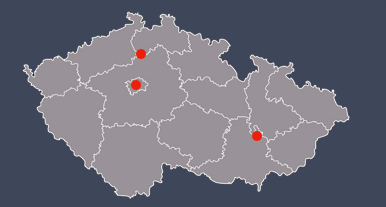
Research
Research
Head of department:
Mrázek Jakub, Ing., Ph.D.
 |
|
Laboratory video (EN subtitles)
Download links: video and English subtitles.
Department activity:
Our group has been studying anaerobic microbes for more than 40 years, with focus on human and animal gut.
Animal gut microbiome plays irreplaceable role – it participates in nutrition processing and production of host beneficial metabolites, it stimulates host’s immune system and prevents contamination of pathogens. The gut microbiome is currently considered as a separate organ with its own individual and evolutionary development. It also plays a key role in many civilization disorders (obesity, diabetes, ulcer colitis, Crohn’s disease, gut cancer,...), and also in diseases not related to gut: autism, Alzheimer’s disease. Two approaches can be used to study microbiome ecosystems: microbiological with isolation and description of new microorganisms, and by molecular genetics, when the microbiome diversity is analysed as whole, without the need of cultivation. Both those approaches are used in our studies.
Characterisation of microorganisms
Methodological ground of our research is isolation and description of new bacterial and fungal taxons, and estimation of their morphology, metabolism and role in host’s ecosystem. We focus on beneficial gut bacteria (bifidobacteria, lactobacilli), and also on potentially technologically important microorganisms with high cellulolytic and xylanolytic activities (butyrate producing bacteria, anaerobic fungi). We also study phylogenetic status (classification and evaluation of evolution of organisms based on molecular markers) of family Bifidobacteriaceae, order Lactobacillales and genera Propionibacterium. Several new microbial species have already been described by our group (table 1.).
Table 1: New microbial species described by LAM.
|
Species |
Order |
Host |
Author |
Published |
|
Butyrivibrio hungatei |
Clostridiales |
Cow |
Kopečný J. |
2003 |
|
Pseudobutyrivibrio ruminis |
Clostridiales |
Cow |
Kopečný J. |
2003 |
|
Butyrivibrio proteoclasticus |
Clostridiales |
Cow |
Kopečný J. |
2008 |
|
Bifidobacterium bombi |
Bifidobacteriales |
bumblebee |
Killer J. |
2009 |
|
Bombiscardovia coagulans |
Bifidobacteriales |
bumblebee |
Killer J. |
2010 |
|
Bifidobacterium actinocoloniiforme |
Bifidobacteriales |
bumblebee |
Killer J. |
2011 |
|
Bifidobacterium bohemicum |
Bifidobacteriales |
bumblebee |
Killer J. |
2011 |
|
Pseudoscardovia suis |
Bifidobacteriales |
Wild pig |
Killer J. |
2013 |
|
Alloscardovia macacae |
Bifidobacteriales |
macac |
Killer J. |
2013 |
|
Lactobacillus rodentium |
Lactobacillales |
Rodent |
Killer J. |
2014 |
|
Lactobacillus bombi |
Lactobacillales |
bumblebee |
Killer J. |
2014 |
|
Pseudoscardovia radai |
Bifidobacteriales |
Wild pig |
Killer J. |
2014 |
|
Lactobacillus apis |
Lactobacillales |
Honeybee |
Killer J. |
2014 |
|
Vagococcus entomophilus |
Lactobacillales |
Wasp |
Killer J. |
2014 |
|
Agathobacter ruminis |
Clostridiales |
Cow |
Kopečný J. |
2015 |
|
Piromyces irregularis |
Neocallimastigales |
sheep |
Fliegerová K. |
2015 |
|
Alloscardovia venturai |
Guinea-pig |
Killer J. |
2017 |
|
|
Bifidobacterium apri |
Bifidobacteriales |
Wild pig |
Killer J. |
2017 |
|
Galliscardovia ingluviei |
Bifidobacteriales |
Laying hen |
Killer J. |
2017 |
|
Lactobacillus caviae |
Lactobacillales |
Guinea-pig |
Killer J. |
2017 |
Picture 1: Microscopic screens of new Bifidobacteriales and Neocallimastigales members.


Microbiome diversities characterisations
Second methodological approach, that does not involve cultivations, is the application of tools of molecular biology: “classical”, based mostly on specific PCR, restriction analyses, electrophoretic separations and Sanger sequencing, and “modern” methods of new generation sequencing (NGS). All those approaches are established in our lab, and are used for both description of new isolates (by whole genome sequencing), and also complex microbial ecosystems by PCR-DGGE, real-time PCR and NGS.
Our projects include analyses of gut microbiome from patients with inflammatory bowel diseases and estimation of treatment (biological treatment by anti-TNFalpha, prebiotics, microbiome transplantation), characterization of metabolic syndrome in schizophrenia patients and role of microbiome in “gut-brain” axis (autism, Alzheimer’s disease). Apart from those human oriented studies, our lab also deals with description and alteration of microbial communities in bio-waste treatment with aim to increase methane production, or contrary focusing on ruminal microbiomes in methane emission reduction.
Picture 2: Gut microbiome of goats fed on different diets (Grilli et al., 2016).

Picture 3: Gut microbiome of habituated (H) and unhabituated (U) gorillas (Gomez et al., 2015).

Cooperations
Many of our studies are performed in cooperation with
- inland medical institutes (IKEM, 2nd medical faculty, ISCARE)
- universities (University of Life Sciences in Prague, VŠCHT, Masaryk University in Brno)
- private research institutes (Agricultural Research, Ltd., Bee Research Institute, Ltd.)
- with other CAS departments (MBI, FGI, IMG, IBV)
Apart from those activities our lab also cooperates with many foreign institutes:
- Rowett’s Research Institute (Great Britain)
- AG Research (New Zealand)
- Ljubljana University (Slovinia)
- Mendoza University (Argentina)
- Innsbruck University (Austria)
- and others...






